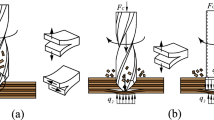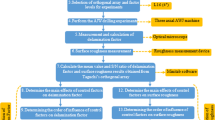Abstract
This research article investigates the minimization of uncut fiber length (UFL) in bidirectional carbon fiber-reinforced polymer (CFRP) drilling through experiments executed using a computer numeric control drilling machine and a titanium nitride-coated drill bit. The cutting conditions, such as the feed rate, spindle speed, and were varied to determine their effects on UFL. Three drilling setups were compared: dry machining, drilling using liquified nitrogen layers, and drilling using ice layers. The results showed that the use of ice improved hole quality and increased drilling efficiency by providing bottom support for the CFRP sheet sandwich, reducing delamination and fiber pull-out. Additionally, the feed rate, cutting speed, and drill geometry significantly influenced hole quality and maximum UFL. Overall, the study sheds light on the usefulness of cooling agents and bottom support for the modification of cutting parameters in bidirectional CFRP drilling.
Similar content being viewed by others
References
Z. Q. Chen et al., Method for accurate fiber length determination from increment cores for large-scale population analyses in Norway spruce, Holzforschung, 70 (2016) 829–838.
A. Hrechuk, V. Bushlya and J. E. Ståhl, Hole-quality evaluation in drilling fiber-reinforced composites, Compos. Struct., 204 (2018) 378–387.
A. P. Jaiswal and H. W. Park, Experimental and analytical examination of multidirectional carbon fiber–reinforced polymers for uncut fibers and their distributions during drilling, Int. J. Adv. Manuf. Technol., 123 (2022) 1323–1339.
Y. Bai, J. Z. Yuan, R. Fu, J. Hao, J. Xuan, F. Wang and F. Ji, Mechanical model for predicting thrust force with tool wear effects in drilling of unidirectional CFRP, Compos. Struct., 262 (2021) 113601.
Z. Jia, C. Chen, F. Wang and C. Zhang, Analytical study of delamination damage and delamination-free drilling method of CFRP composite, J. Mater. Process. Technol., 282 (2020) 116665.
C. Ramirez, G. Poulachon, F. Rossi and R. M’Saoubi, Tool wear monitoring and hole surface quality during CFRP drilling, Procedia CIRP, 13 (2014) 163–168.
G. Poulachon, J. Outeiro, C. Ramirez, V. André and G. Abrivard, Hole surface topography and tool wear in CFRP drilling, Procedia CIRP, 45 (2016) 35–38.
X. Qiu et al., Study on chisel edge drilling behavior and step drill structure on delamination in drilling CFRP, Compos. Struct., 203 (2018) 404–413.
F. Wang, B. Qian, Z. Jia, R. Fu and D. Cheng, Secondary cutting edge wear of one-shot drill bit in drilling CFRP and its impact on hole quality, Compos. Struct., 178 (2017) 341–352.
E. Kilickap, Investigation into the effect of drilling parameters on delamination in drilling GFRP, J. Reinf. Plast. Compos., 29 (2010) 3498–3503.
Ş. Bayraktar and Y. Turgut, Determination of delamination in drilling of carbon fiber reinforced carbon matrix composites/Al 6013-T651 stacks, Meas. J. Int. Meas. Confed., 154 (2020) 107493.
J. P. Davim and P. Reis, Study of delamination in drilling carbon fiber reinforced plastics (CFRP) using design experiments, Compos. Struct., 59 (2003) 481–487.
V. Krishnaraj et al., Optimization of machining parameters at high speed drilling of carbon fiber reinforced plastic (CFRP) laminates, Compos. Part B Eng., 43 (2012) 1791–1799.
N. Shetty, M. A. Herbert, R. Shetty, D. S. Shetty and G. S. Vijay, Soft computing techniques during drilling of bi-directional carbon fiber reinforced composite, Appl. Soft Comput. J., 41 (2016) 466–478.
M. A. J. Bosco, K. Palanikumar, B. D. Prasad and A. Velayudham, Influence of machining parameters on delamination in drilling of GFRP-armour steel sandwich composites, Procedia Eng., 51 (2013) 758–763.
C. Chen et al., A study on drilling of CFRP/Ti stacks: temperature field and thermal damage of the interface region, Materials (Basel), 16 (2023) 1–13.
M. Altin Karataş, A. R. Motorcu and H. Gökkaya, Study on delamination factor and surface roughness in abrasive water jet drilling of carbon fiber-reinforced polymer composites with different fiber orientation angles, J. Brazilian Soc. Mech. Sci. Eng., 43 (2021) 1–29.
L. Shu et al., Study on dedicated drill bit design for carbon fiber reinforced polymer drilling with improved cutting mechanism, Compos. Part A Appl. Sci. Manuf., 142 (2021) 106259.
J. Xu and M. El Mansori, Experimental study on drilling mechanisms and strategies of hybrid CFRP/Ti stacks, Compos. Struct., 157 (2016) 461–482.
J. Xu, T. Lin, J. P. Davim, M. Chen and M. El Mansori, Wear behavior of special tools in the drilling of CFRP composite laminates, Wear, 476 (2021) 203738.
J. Seo, D. Y. Kim, D. C. Kim and H. W. Park, Recent developments and challenges on machining of carbon fiber reinforced polymer composite laminates, Int. J. Precis. Eng. Manuf., 22 (2021) 2027–2044.
Acknowledgments
This research was supported by the National Research Foundation of Korea (NRF) funded by the Ministry of Science and ICT of Korea (NRF-2022R1A2C3007963) and the Development of smart manufacturing multiverse platform based on multisensory fusion avatar and interactive AI funded by the Ministry of Trade, Industry, and Energy (20025702).
Author information
Authors and Affiliations
Corresponding author
Additional information
Anand Prakash Jaiswal is presently a Ph.D. candidate specializing in Mechanical Engineering at the esteemed Ulsan National Institute of Science and Technology (UNIST) in South Korea. His current academic pursuit involves the attainment of a doctoral degree in the field of machining of Carbon Fiber Reinforced Polymer (CFRP) materials at UNIST. The focal point of his scholarly endeavors revolves around analytical modeling and the optimization of machining techniques applied to composite materials.
Hyung Wook Park is an esteemed Professor of Mechanical Engineering at Ulsan National Institute of Science and Technology (UNIST), South Korea. He holds a Ph.D. from Georgia Institute of Technology, USA, and received his B.S. and M.S. degrees from Seoul National University, Korea. Professor Park’s research interests encompass machine tools, metal cutting processes, non-traditional machining techniques, surface texturing using metal cutting, FEM modeling, and advancements in robot manufacturing. His contributions significantly enrich the academic and scientific community, enhancing knowledge and understanding in these critical areas of research.
Rights and permissions
About this article
Cite this article
Jaiswal, A.P., Park, H.W. Experimental investigation of the minimization of uncut fiber length in bidirectional CFRP drilling. J Mech Sci Technol 37, 6173–6180 (2023). https://doi.org/10.1007/s12206-023-2410-5
Received:
Revised:
Accepted:
Published:
Issue Date:
DOI: https://doi.org/10.1007/s12206-023-2410-5




